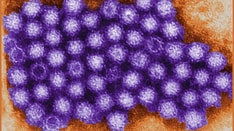Background
Coxsackieviruses belong to the family Picornaviridae and the genus Enterovirus, which also includes poliovirus and echovirus. [1] Enteroviruses are among the most common and important human pathogens with 9 different species classified(Enterovirus A-H and I). [2] Enterovirus C includes poliovirus 1-3, whereas Enterovirus A, B, and C include the numbered coxsackieviruses. Coxsackieviruses share many characteristics with poliovirus. With control of poliovirus infections in much of the world, more attention has been focused on understanding the nonpolio enteroviruses such as coxsackieviruses.
Coxsackieviruses are nonenveloped viruses with linear single-stranded RNA. [1] Coxsackieviruses are divided into group A and group B viruses based on early observations of their pathogenicity in mice. Group A coxsackieviruses were noted to cause a flaccid paralysis that was caused by generalized myositis, whereas group B coxsackieviruses were noted to cause a spastic paralysis due to focal muscle injury and degeneration of neuronal, pancreatic, and myocardial tissue. At least 23 serotypes (1-22, 24) of group A and 6 serotypes (1-6) of group B are recognized.
In general, group A coxsackieviruses tend to infect the skin and mucous membranes, causing herpangina, acute hemorrhagic conjunctivitis (AHC), and hand-foot-and-mouth (HFM) disease. Group B coxsackieviruses tend to infect the heart, pleura, pancreas, and liver, causing pleurodynia, myocarditis, pericarditis, and hepatitis. Both group A and group B coxsackieviruses can cause nonspecific febrile illnesses, rashes, upper respiratory tract disease, and aseptic meningitis.
Numerous group A coxsackieviruses are responsible for causing CNS disease similar to poliomyelitis. Systemic neonatal disease often is associated with group B coxsackieviruses.
The development of insulin-dependent diabetes (IDDM) has been associated with recent enteroviral infection, particularly coxsackievirus B infection. [3]
The Centers for Disease Control and Prevention (CDC) have rigorously evaluated cases of acute flaccid myelitis (AFM) since 2014, when an increased number of cases were reported. AFM is a CNS disease that specifically affects the spinal cord gray matter, causing muscle and reflex weakness. Most reported AFM cases do not have an identified etiologic pathogen. However, coxsackievirus A16 has been one of the viruses recovered from cerebrospinal fluid in a small number of confirmed cases.
Pathophysiology
Coxsackieviruses primarily are transmitted via the fecal-oral route and respiratory aerosols, although transmission via fomites also is possible. Viral replication initially occurs in the upper respiratory tract, particularly the tonsils, and the distal small bowel. Viremia with systemic dissemination then occurs and involves the reticuloendothelial system, which leads to further replication in other anatomic locations and organs and ultimately to development of symptoms. [4] Central nervous system (CNS) invasion is proposed to occur from viral migration along peripheral and central nerves into the CNS. [4] Coxsackieviruses have been identified in the respiratory tract up to 3 weeks after initial infection and in feces up to 8 weeks after initial infection. Innate, humoral and cell-mediated immunity all play a role in the body's response to enteroviral infection. [5] However, the infection frequently is eradicated before antibody production occurs. [5]
Epidemiology
Frequency
United States
Approximately 10 million symptomatic enteroviral infections are estimated to occur annually in the United States. From 2002-2004, an estimated 16.4-24.3% of these illnesses were attributed to coxsackievirus serotypes. For 2 of the 3 years, coxsackievirus B1 was the predominant serotype. Enteroviruses are responsible for approximately 30,000 to 50,000 hospitalizations per year. The CDC found that coxsackievirus infections accounted for approximately 25% of all neonatal enterovirus infections (26,737) from 1983 to 2003. Those due to coxsackievirus B4 were associated with a higher mortality rate than any other serotype.
The CDC reports coxsackievirus A16 as the virus most frequently isolated in hand, foot, and mouth disease (HFMD). Similarly, coxsackievirus A6 was the most frequently reported enterovirus from 2009-2013.
International
Coxsackievirus infections have worldwide distribution. They can be isolated year-round in tropical climates, with a decreasing incidence of disease and seasonality in areas of higher latitude.
Severe Acute Respiratory Syndrome Coronavirus 2 (SARS-CoV-2) Co-infections
The COVID-19 pandemic, caused by SARS-CoV-2, has significantly impacted the epidemiology of other respiratory viral pathogens. [6] Among patients with SARS-CoV-2 co-infection, rhinoviruses and respiratory enteroviruses are the leading causative pathogens. [7] This could be attributed to their non-enveloped nature and prolonged survival, which contribute to them being less susceptible to nonpharmaceutical interventions such as mask wearing and surface cleaning. [8, 9] Additionally, the majority of these co-infections manifest as mild COVID-19. [7]
Mortality/Morbidity
Mortality due to coxsackievirus infection is uncommon. Neonates and immunocompromised individuals are at highest risk for complications secondary to enteroviral infections.
Sex
During the first decade, enteroviral infections are more common in males, with a male-to-female ratio of 2:1. The reason for this disparity is not well understood.
Age
Coxsackievirus infections occur in all age groups but are more common in young children and infants. Children are at higher risk for infection during the first year of life. The rate of incident infection decreases substantially after the first decade of life.
Prognosis
In general, the prognosis for coxsackievirus infection is quite good, with over 90% of patients having no symptoms or experiencing mild, self-limited, nonspecific febrile illnesses or rashes. [10, 11]
Patient Education
Patients should be aware of the need for good hygiene practices to avoid transmission of coxsackievruses.
Patients can be reassured that they most likely have a self-limited viral illness that does not require antibiotics.







